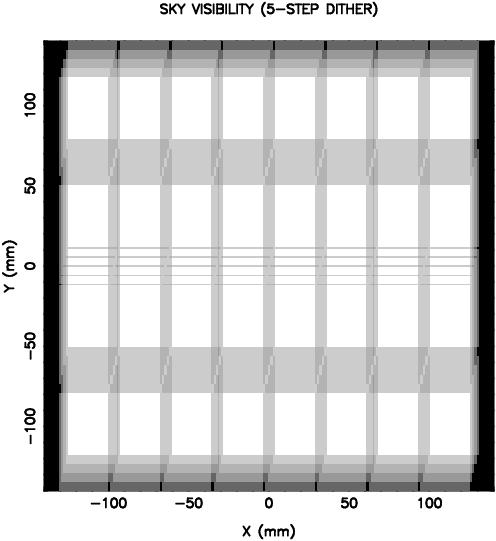Technical specifications
Exposure times and photometric sensitivity
The following table lists for the four filters in which KiDS observes the exposure times and the sensitivity that is reached. Total exposure times are split over five individual exposures in the case of g, r and i to aid in cosmic ray rejection and cover the inter-CCD gaps; in the case of u-band four exposures are obtained.
| Band | Exp. time (s) | Mag. limit (5σ 2'' AB) | Seeing ('') | Moon phase |
|---|---|---|---|---|
| u | 1000 | 24.8 | 0.9 - 1.1 | Dark |
| g | 900 | 25.4 | 0.7 - 0.9 | Dark |
| r | 1800 | 25.2 | <0.7 | Dark |
| i | 1200 | 24.2 | <1.1 | Any |
A comparison of KiDS imaging data with SDSS and CFHTLS can be found here.
Tiling strategy
To avoid gaps in the KiDS photometry the inter-CCD gaps have to be bridged. This is done by using a 5-step dither pattern (Fig. 1). At the edges of the fields, the exposure level decreases from 5 to 0, in a staircase pattern with step width equal to the dither steps (25 arcsec in X, 85 arcsec in Y). This 5-step dither pattern is used for observations in the g, r and i filters, while for u-band a 4-step dither pattern is used. This choice was made to allow longer individual exposures, necessary due to lower CCD sensitivity in u, but results in a less uniform coverage in u.

|
Figure 1: Sky visibility in the default 5-step dither pattern used for KiDS. White indicates area covered in all five exposures, with progressively darker shades indicating lower and lower total exposure time. |
KiDS survey tiles are placed on the sky based on the OmegaCAM PlateSystem. This system provides a grid of tile centers that evenly and with minimum overlaps covers the full sky (see Tiling the sky for OmegaCAM).
In this tiling scheme the field centers are separated by 3623arcsec = 60.4arcmin in X (RA), and 3530arcsec=58.8arcmin in Y (Dec). At the tile boudaries there is a strip that has received four exposures in one of the tiles and three in the adjacent tile, providing redundancy. The resulting exposure pattern is shown in Fig. 2.

|
Figure 2: Exposure pattern from a 2x2 set of fields. The darkest shade of grey represents 3/5 of the total exposure time. |
